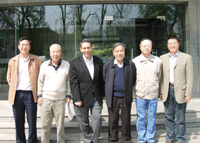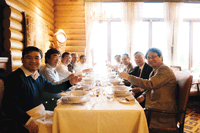SIAM Honors Distinguished Members, Works to Strengthen Ties with Colleagues Around the Globe
August 1, 2009

Forging connections is a hands-on endeavor for SIAM president Doug Arnold, shown here in Beijing, at the Chinese Academy of Sciences, with a few of the many Chinese applied and computational mathematicians he has met so far; from left: Ya-xiang Yuan, president of the Operations Research Society of China; Lin Qun, Chinese liaison to SIAM; Zhong-ci Shi, president of the Chinese Society of Computational Mathematics and Chinese representative to the East Asia section of SIAM; Zhiming Ma, president of the Chinese Mathematical Society; and Zhiming Chen, director of the Institute of Computational Mathematics and Scientific/ Engineering Computing and vice president of the Chinese Society for Industrial and Applied Mathematics. Arnold was in China to present the first Feng Kang Distinguished Lecture at the Academy's ICMSEC.
Talk of the Society
James Crowley
Congratulations to the inaugural class of SIAM fellows! Approved by the membership in our fall 2008 election, the SIAM Fellows Program became a reality early this year with the announcement of the first class of fellows. The 191 individuals in the group were selected on the basis of criteria specified in the resolution approved by the membership.
We are now in the process of creating a Web form that members can use to nominate new fellows. Beginning on September 1, nominations for the 2010 class of fellows will be accepted.
The nominations will be reviewed by a committee made up of current fellows. One of the activities of the Major Awards Committee at its July meeting in Denver, during the SIAM Annual Meeting, will be the appointment of 12 fellows to the first Fellows Selection Committee. Roughly 35 fellows will be appointed next year, and over the initial decade the numbers of new fellows will ramp down to a steady state of between 20 and 25 per year (with the exact number determined as a percentage of membership).
For now, we have a stellar list of fellows of whom we can all be proud. Nothing is perfect, of course: We would have liked to see more people from industry on the list (which includes about 6% each from industry and government), and the representation of women (8%) is lower than we would prefer. The hope is that in the long term, through the nomination process, SIAM members will eliminate some of these imbalances.
Focus on China
To define another SIAM membership initiative as a new Web page is to understate both the effort that went into its design and the benefits it was created to provide. It is a Web page (http://www.siam.org/membership/individual/china.php), one that was specially designed for residents of the People's Re-public of China; it includes a SIAM membership form, in both Chinese and English, that can be completed online, along with PDF versions of the forms that can be down-loaded and submitted by e-mail, fax, or mail. New Chinese members can pay their dues in RMB yuan through a Chinese bank.
"China has a large and active group of applied and computational mathematicians," says SIAM president Doug Arnold. "Through individual membership in SIAM, these scientists will have closer connections to the international community, and SIAM will benefit from their involvement and ideas. It's a win�win situation. That's why I have made this a major priority at the start of my presidency."
Crucial to the success of the new mechanism for involving the large Chinese applied and computational mathematics community in SIAM activities is Arnold's partner on the ground: Lin Qun of the Academy of Mathematics and Systems in the Chinese Academy of Sciences, in Beijing. Consulted by Arnold about the difficulties for many Chinese scientists of paying in U.S. dollars, Lin volunteered to translate applications submitted in Chinese into English, and then forward all applications and payment to SIAM headquarters.
Report from Oslo
As one of the four original ICIAM societies (along with GAMM, IMA, and SMAI), SIAM has been involved in the planning of the quadrennial congresses ever since the first, held in Paris in 1987. Our participation in the annual meeting of the ICIAM Board had heightened significance this year: Along with our Canadian partners CAIMS and MITACS, we are running ICIAM 2011 in Vancouver, British Columbia.
The 2009 board meeting was held in May in Oslo, Norway, in conjunction with the Abel Prize ceremonies, which some of us from SIAM (Doug Arnold, Guillermo Sapiro, and I) had the opportunity to witness firsthand. Although the Abel Prize is not geared toward applied mathematics, some of the six recipients to date, notably Peter Lax and Srinivasa Varadhan, were honored for contributions in many areas of mathematics, including applications.
Mikhail Gromov, this year's recipient, was cited "for his revolutionary contributions to geometry"---which, again, might seem to be far removed from applications. But this is not so, as made clear in a wonderful addition to the Abel Prize events this year: an invited Science Lecture on applications of the prize recipient's work. Guillermo Sapiro, the first editor-in-chief of SIAM Journal on Imaging Sciences, delivered the inaugural Science Lecture. In it, he discussed applications of Gromov's work, specifically the Gromov�Hausdorff distance in computer vision. His article presenting the main points for readers of SIAM News begins on the first page of this issue.
At the conclusion of the Abel ceremonies and lectures, the ICIAM Board met for a very full day. Included in a dense agenda was election of the next president of ICIAM. I'm pleased to report that the board chose Barbara Keyfitz to fill the position; she will succeed Rolf Jeltsch in the fall of 2011, following the Vancouver congress.
Another important decision to be made was the site for ICIAM 2015. The board selected Beijing; CSIAM, the Chinese Society for Industrial and Applied Mathematics, will host the congress, which in a departure from tradition will be held in late August, rather than July.
ICIAM 2011 will be held in Vancouver, July 18�22. To accommodate those who need early acceptance for visa purposes, a Web site (http://meetings.siam.org/start.cfm?CONFCODE=ic11) is open for submissions.
In Oslo, the board took a major step toward the organization of ICIAM 2011 by approving the invited speakers---perhaps the first time the slate was approved with-out major revisions. This unprecedented smoothness was due in part to a new procedure that relied on panels to develop lists of speakers. In addition to engaging a larger part of the community in the consideration of possible speakers, the panels have the advantage of putting the selection of speakers in the hands of experts in the various areas. The efficient operation can also be attributed to the hard work of Jerry Marsden and Ivar Ekeland, co-chairs of the Scientific Program Committee. The list will be posted on the ICIAM 2011 Web site as soon as it is finalized.

ICIAM 2015 takes shape. Dining in Oslo during the ICIAM committee meeting were (clockwise, from left foreground): Lei Guo, Shin'ichi Oishi, Ya-xiang Yuan, James Crowley, Zhong-ci Shi, Taketomo Mitsui, Douglas Arnold, Tatsien Li, and Hisashi Okamoto. Photo by Eivind Stensnes.

